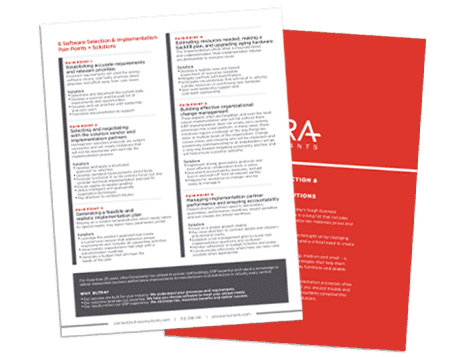Expert Q&A Manufacturing Execution Systems
A manufacturing execution system (MES) offers different things to different manufacturers – and different things to manufacturers in different industries. To help reduce the confusion, and to provide insight into the value of MES solutions in the industrial equipment and industrial products verticals, we asked Ultra Industry Marketing Director Dave Lechleitner (DL), a longtime consultant to industrial products companies, to share his expertise. Here is an edited version of the conversation:
Q&A Manufacturing Execution Systems
Let’s start with the most important question: Why would a manufacturer implement an MES?
DL: In the broadest sense, an MES is makes it easier to manage the manufacturing process and to accelerate the order-to-cash cycle. If you can manage production better, and, by doing that, reduce the amount of time between when the customer places the order and when it ships, then you improve revenue, DSO and cashflow.
And, an MES offers important visibility into equipment utilization, which is the key to effective and efficient production planning. We ask clients to estimate their production utilization rate. And they all give us a number between 70% and 90%. But when we start analyzing their production data, the real percentage is much, much lower. They always are surprised that they have significant unused capacity. The fact is, the average industrial products manufacturer utilization rate is 35%.
The bottom line? Every manufacturer makes its money on the shop floor. An MES offers insight and information that enables increased production efficiency, improved planning, sequencing and scheduling, and the opportunity to recover “hidden” capacity.
Doesn’t an ERP do that?
DL: Some ERPs do come with embedded MES capabilities. Some offer add-on MES modules. And some integrate with third-party MES solutions. But most do not offer the same capabilities and functions of standalone MES solutions.
An end-to-end MES – however it’s delivered – bridges the gap between your machines and your ERP solution. When you connect the data streams from your shop floor to your ERP, you have additional critical production data that can be tracked, monitored and analyzed.
Actually, we find that an MES often is the catalyst for a new ERP solution. And for companies with a legacy ERP that are not ready to buy and implement a new ERP, an MES can be a steppingstone – an interim solution that can be built atop their existing system. So, they can avoid taking that big leap and still get many of the benefits.
We’ve defined MES, and discussed its general functions in a related blog post. What specifically does an MES do?
DL: An MES solution monitors and measures three areas: Production (the rate of parts production), quality (dimensions, weight and appearance of parts produced) and processes (production variables like temperature, pressure and hold time). And each area produces actionable information that can be used on its own or combined with other data from an ERP solution or other systems.
For example, production monitoring can inform production management that a machine is running or stopped, that a particular job is running (and when it will be complete), how many parts have been made, or if a job is running too slowly (and there is a problem).
When you monitor and measure production in real time, you have valuable information that can be directed to your ERP system – information like
6 Software Selection & Implementation Pain Points + Solutions
Software selection and implementation processes often present challenges of their own. To steer you around trouble and help you drive success, Ultra’s experts compiled a list of pain points and solutions to be aware of as you embark on this journey.
how many products will be available (and when), how many parts were consumed, how much machine and labor time was used to make the products, when the machine will be available for the next job (for planning purposes)
Quality monitoring collects data from your devices throughout the shop floor – like sensors, scales, calipers and test systems. Quality monitoring builds on the data from production monitoring, letting you know important KPIs like scrap rates and the amount of wasted material, labor and production time.
Process monitoring lets you know what is happening during production. For example, was the part made at the right temperature? It also is essential for root cause analysis of manufacturing quality issues.
What would you say are the primary benefits of an MES?
DL: The number one benefit would be insight and integration. For example, by collecting machine data from the shop floor and integrating it with the order data in your ERP, an MES gives you the insight you need to plan accurately and produce efficiently.
Number two: comprehensive reporting. With the shop floor and machine-level data streams delivered by an MES, and its advanced reporting tools, you can view and monitor KPIs and analyze performance data – and then use that information to find efficiencies, discover waste, and determine areas for improvement.
Number three: advanced visualizations. An MES gives you the ability to really see what’s happening on the shop floor – and manage smarter – with real-time visualizations of production and machine performance data.
Have More Questions about Manufacturing Execution Systems?
For expert guidance on MES system selection and process improvement, reach out to the Ultra team for your free discovery call.







